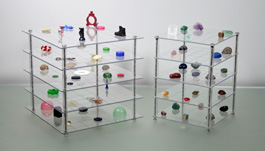| |
| The Communicube
was invented during doctoral research with adults who were all clients
of NHS mental health services (Casson, 2002). They were variously
diagnosed with mental illnesses, particularly schizophrenia. Many
were survivors of abuse.
|

Photo by Paul Melia
|
To ensure that clients
were not overwhelmed by their experience in therapy I chose to work
in miniature and therefore used button sculpting. Since the dawn
of human history, shamans and healers have used symbolic arrangements
of objects, shells, stones and bones to diagnose and treat illness.
Today, dramatherapists and other creative therapists use button
sculpting, a projective method, during which clients arrange buttons
in symbolic patterns.
I have been able to demonstrate through my qualitative
research the value of this structure as a container that prevents
clients from being overwhelmed. (See chapters 6 & 7 in my book:
Drama, Psychotherapy and Psychosis) Jo Christensen, dramatherapist
has researched the use of the Communicube with young people for
her M.A. at Exeter University.
|
|
|
Although the Communicube was invented during dramatherapy
research it has much wider applications. It is being used by therapists
of many different orientations including psychodramatists, gestaltists,
psychosynthesists, transactional analysts, counsellors (including
those working with couples), psychologists, psychiatrists and other
creative psychotherapists.
The structure is neutral: the levels can mean anything the client
wishes. For example they may represent different times in a person’s
life with the top level being the future, the bottom being the past,
the centre being the present and the intermediate levels being the
immediate past and the immediate future. |
 Photo By Padmakara (Roger Bygott)
|
The Communicube has also been used
effectively to explore individual and group spirituality. For example:
Buddhists have a five level model of the world and of the mind. (See
the user's manual for more details.)
|
|
|







